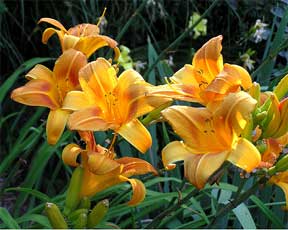What perennial is more versatile, more adaptable than the hemerocallis or day-lily? It thrives in either open shade or brilliant sun, acid soil or alkaline and, in some cases, even survives considerable drought. With practically no care at all, day-lilies grow luxuriantly.
Until about 75 years ago the only day-lilies present in America were the yellow and orange species, originally natives of the Orient and brought to America by the early colonists. But since 1930, when a pink-flowered species from China was introduced, day-lilies have been hybridized extensively, resulting in many new colors and bloom types.

Today they are available in a wide variety of colors from deep maroon to many striking combinations of red, orange and yellow. With a planting of early, mid season and late-flowering varieties, it is now possible to have day-lilies in bloom from spring until frost. With their wide color range and long blooming season, day-lilies are particularly desirable in the landscape. When combined with such seasonal flowering plants as tulips, peonies or bearded iris, they extend the show of color through the summer and into the fall.
2 Varieties – 1 Clump
Day-lilies add a spicy note to the perennial garden. When two varieties are combined in one clump, the effect has added zest. Such a combination might be maroon and light yellow, buff and mauve, tan and brown. Once planted, day lilies need little care. They withstand considerable drought and will thrive in either bright sun or light shade.
Irregular plantings in lightly-shaded spots under trees can provide the same brilliant display throughout the summer that daffodils do in spring. Clumps of dwarf varieties, when planted in a rock garden or at the base of a stone wall are very effective.
To add a bit of spice to the color scheme or to save space in the garden, combine several varieties of different colors in one clump. This novel effect shouldn’t be overdone, however.
Once planted, a day-lily clump needs little care besides a light feeding in spring and fall. When the clump gets crowded, it can be dug up, divided and replanted. Daylilies can be transplanted any time, even when in bloom if necessary.
When used in arrangements, day-lilies provide color for a considerable length of time. New buds continue to open day after day, and if the faded flowers are removed the arrangement will be attractive for a week or more.
The gardener who has a yen to hybridize plants could do no better than to start with day-lilies. The technique of cross—pollination is not difficult; the seed pods will ripen in about six weeks and then the seeds can be planted immediately. Results of the cross can be seen the second year, when the seedlings will bloom in your garden for the first time.
